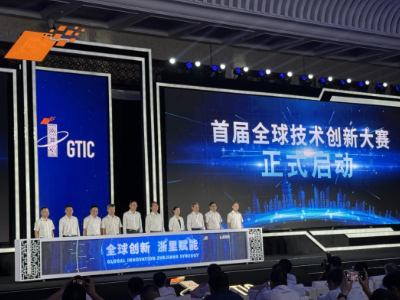07-30
Hong Kong: A Hub of Innovation Leading the Future of AI in Healthcare,The 2nd CREATE Symposium Hosted by CAIR Concludes Successfully
 2024-11-26
2024-11-26
 Centre for Artificial Intelligence and Robotics (CAIR), Hong Kong Institute of Science & Innovation, Chinese Academy of Sciences
HaiPress
Centre for Artificial Intelligence and Robotics (CAIR), Hong Kong Institute of Science & Innovation, Chinese Academy of Sciences
HaiPress
HONG KONG,Nov. 26,2024 -- In recent years,the integration of artificial intelligence (AI) and robotics into the medical field has revolutionized healthcare technologies. The focus now is on bridging the gap between cutting-edge technologies and clinical applications to enhance diagnostic capabilities and improve overall healthcare efficiency. On November 22-23,the Centre for Artificial Intelligence and Robotics (CAIR),Hong Kong Institute of Science and Innovation,Chinese Academy of Scienceshosted the Second Hong Kong Clinical-driven Robotics and Embodied AI TEchnology Symposium(CREATE Symposium)at the Charles K. Kao Auditorium,Hong Kong Science Park.
This two-day symposium brought together a distinguished lineup of international experts,clinicians,and medical device innovators to foster cross-disciplinary dialogues spanning academic research,industry development,and clinical applications. Participants exchanged insights on the latest breakthroughs and future trends in healthcare technologies,propelling the innovative application of AI and robotics in medical practice.
Following the success of the first day,the second day of the CREATE Symposium featured insightful discussions by more than 10 experts,focusing on the applications of AI in medical device innovation and clinical practices. In his welcome speech,Professor Zhen Lei,IEEE/IAPR Fellow and Professor of CAIR emphasized CAIR's mission: "CAIR is committed to becoming an international R&D hub for scientific and technological innovation,advancing AI research and intelligent design,and fostering new momentum for both mainland and international communities. By bringing together global talent and technology,we aim to establish Hong Kong as an international hub for innovation in intelligent technology."Mr. Changlin Gao,General Manager of Beijing-Hong Kong Exchange of Personnel Centre,representing one of the supporting organizations,highlighted the forum's role in creating a high-level platform for collaboration: "This forum has established a platform for the international academia,industry,and medical community to jointly explore the cutting-edge applications and future directions of AI technology in healthcare.
From Exploration to Practice: AI Empowering the Future of Healthcare
Professor Dinggang Shen,Founding Dean of the School of Biomedical Engineering at the ShanghaiTech University and Co-CEO of United Imaging Intelligence,highlighted how AI technology is advancing the standardization and intelligent development of medical diagnoses and treatments. By integrating multimodal data,including imaging,pathology,and genomics,AI is improving medical efficiency,optimizing resource allocation,and enhancing patient outcomes. He also shared his team's innovative work in areas such as image enhancement,low-dose imaging,and comprehensive cancer diagnosis.
In the field of surgery,embodied AI technology is gradually being integrated into minimallyinvasive procedures and surgical robots,providing surgeons with high-precision,low-risk assistance. Professor Hongbin Liu,Director of CAIR,stated that the goal of AI is to empower rather than replace humans,enabling doctors to become "super doctors". He envisioned the future operating rooms become fully intelligent spaces where humans and robots collaborate seamlessly,improving surgical outcomes through advanced interaction. .
Professor ShaohuaZhou,Executive Dean of the School of Biomedical Engineering at the University of Science and Technology of China,emphasized the growing importance of general and foundational models in medical imaging AI. These models address challenges related to data scarcity and task complexity through a "train-once,multi-task" approach. He highlighted the integration of multimodal data and the combination of generative and discriminative models to develop reliable and interpretable intelligent systems capable of supporting clinical applications and improving patient health predictions.
Some other distinguished experts and scholars shared their latest research progress and practical applications: Dr. Yongjian Chen,Deputy General Manager of Qingdao Hisense Medical Equipment Co.,Ltd.; Dr. Qi Dou,Assistant Professor at Department of Computer Science and Engineering and T Stone Robotics Institute,The Chinese University of Hong Kong; Professor Zhong Wu,Director of Administration,Chief Physician at Cardiovascular Surgery,West China Hospital of Sichuan University; Dr. Kevin Ka-ho Kam,Director of Ambulatory Cardiology Services and Associate Consultant of Medicine & Therapeutics,Prince of Wales Hospital; Professor Lei Du,Chief Physician and Professor atthe Department of Anesthesia,West China Hospital,Sichuan University; Dr. Huai Liao,Chief Physician at Department of Pulmonary and Critical Care Medicine,First Affiliated Hospital of Sun Yat-sen University; Dr. Shifang Li,Chief Physician,Neurosurgery,Affiliated Hospital of Qingdao University;Dr. Hua Wang,CTO of Magspin Instrument Co.,Ltd.
In the afternoon,the speakers visited the CAIR exhibition hall to explore CAIR's groundbreaking research achievements. Highlights included: CARES Copilot 2.0,Embodied Intelligent Ultrasound Robot,Augmented Reality Navigation Systems,Medical Imaging Enhancements Techniques,Real-time Surgical Digital Twin System,and Flexible Minimally Invasive Neurosurgery Robot. The visit sparked in-depth discussions on addressing clinical challenges and market commercialization. Later,a closed-door seminar focused on the clinical applications of AI and robotics in cardiothoracic surgery and intensive care.
Earlier,around 40 young scholars from Hong Kong had visited the CAIR exhibition hall. They participated in a lunch discussion with project researchers,expressing strong interest in CAIR's research achievements and team culture. Many expressed their aspirations to join CAIR in the future.
The successful conclusion of the "Hong Kong CREATE Symposium"not only highlights its pivotal role in advancing academic exchange and collaboration in the field of embodied intelligent medical technology,but also provides a cross-disciplinary and international platform for innovative dialogue among global experts and scholars. By uniting industry leaders,showcasing groundbreaking research,and delving into emerging trends,the forum serves as a catalyst for the continued evolution and practical application of embodied intelligent medical technology.
Looking ahead,as these technologies continue to evolve and expand,their transformative potential in the healthcare sector will be further unlocked. This progress will not only drive innovation but also strengthen efforts toward the sustainable development of human society,offering new insights and solutions to global healthcare challenges.
About CAIR
Hong Kong Institute of Science & Innovation,Chinese Academy of Sciencesis the first national-level R&D institution in Hong Kong approved by the central government. It is also directly affiliated with the Chinese Academy of Sciences. The Centre for Artificial Intelligence and Robotics(CAIR) is one of the two innovation centers under its umbrella. CAIR focuses on research in areas such as multimodal AI surgical models,embodied AI medical robots,and the fundamental theories of AI. The goal is to build Hong Kong into an artificial intelligence hub with national support,attract international high-end talents,and establish an international innovation hub for the applications of artificial intelligence and robotics in medical technology and life sciences.
For more information,please visit CAIR's WeChat public account or the Center's official website: https://www.cair-cas.org.hk




